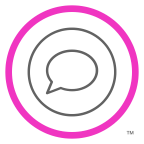The /b/ sound is early developing, and is one of the consonant sounds that many babies master first.
Use sound shaping from /m/
One of the easiest ways to get an instant /b/ is by having kids produce /m/, then occluding their nostrils. This will redirect the energy and airflow into and out of the oral cavity, resulting in a /b/-like production. Have kids hold their hand in front of their mouth, and give feedback about how the air came out of their mouth by saying things like “great job, did you hear/feel how the air came out your mouth!?” Do a couple repetitions and see if they can produce this “mouth sound” with “no hands” and model a /b/. Puff your cheeks with air during your model to help remind them about the oral airflow.
Teletherapy hack
because nostril occlusion is kind of hard to achieve remotely, here’s how to teach a child to do it themselves! The best way to teach kids to do is a method championed by Lynn Marty-Grames, the amazing cleft care clinician, and has the following steps: Make two fists with both hands and hold them up by your face Stick out your thumbs Stick up your pointer fingers Stick out your elbows (chicken wings!) Push your nose closed with your pointer fingers! Kids are great at occluding their own nostrils this way, and often prefer it! If a parent is helping to occlude nostrils with pointer fingers, and in a teletherapy session, the parent should be sitting behind the child so that the kiddo can still see the therapist and the therapist can still see the child’s mouth.
Sound shaping from a bilabial raspberry
We all have made raspberries before—these are the blowing on babies’ tummy sounds and the “car goes bbbbbb” sounds…the raspberry is sometimes easier to get kids to imitate than a /b/ sound, even if attempting /b/ in isolation. Raspberries carry no linguistic load that triggers a phonological substitution pattern. So, if a child is substituting a glottal stop, an /m/, or a /p/ for a /b/ sound (or any other substitution for that matter—those are just some common errors), then having them imitate a raspberry during sound play can be a great way to get started. Once they’re making raspberries on command, see if you can use this as a prime to get some /b/ word vocabulary going. For example, playing with cars and making the “car” sound, and then saying words like “boom” with an exaggerated /b/ can sometimes be enough to elicit this sound for the first time. Even better if a car goes “boom” into a “ball” or a “bear!” Other strategies can be to slow down your raspberry models, like “bbbbbb-buhbuhbuh” to shift from modeling a raspberry to a syllable of “buh.” If the child is making raspberries, try to get an imitation of a “buh” production by cueing “good lip sound! Can you make a short one now? “buh.”
Conclusion
After you’ve got some /b/ sounds started in isolation and syllables, see if you can get that great sound into some words! We’ve got free initial /b/ flashcards as a printable over on our free downloads page.
